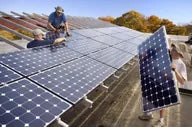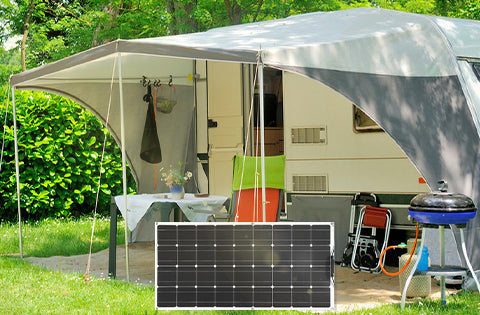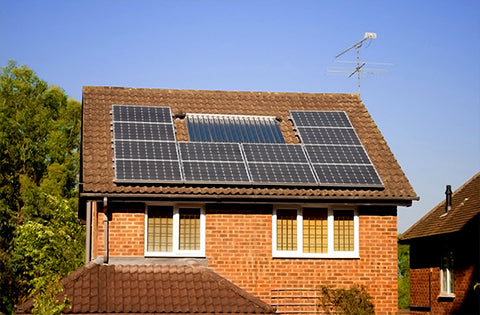What Is Solar Power for the Home?
Homeowners who install solar power systems can receive numerous benefits: lower electric bills, lower carbon footprints, and potentially higher home values. But these benefits typically come with significant installation and maintenance costs and the magnitude of the gains can vary widely from one house to another.
This article will help homeowners make the financial calculations required to determine the viability of solar power in their homes.
KEY TAKEAWAYS
- Those seeking to go green may want to consider equipping their home with solar panels.
- Not only is solar power good for the environment, but you can earn money selling back excess power to the grid.
- While costs have come down over the past years, installation and maintenance of solar panels can be quite expensive.
- Solar panels are best suited for homes that receive ample sun exposure throughout the year.
- Before committing to solar power, be sure to understand both the social and economic factors.
Understanding Solar Power
In principle, working out whether it makes financial sense to install solar power for your home is simple. You will need to calculate:
- The cost of a solar power system
- How much energy it will produce
- What you would otherwise pay for the same amount of energy
- How many years it will take for your upfront investment to pay for itself in saved energy costs
- Whether the system will pay for itself in five years
If it does and you have the upfront capital, it's probably a great idea. If you'll have to wait longer for savings or take out a loan to afford the system, you'll need to think the decision through carefully.
In practice, however, things are not this simple. There is a large variation in each of these factors, and that can make the costs and benefits of installing solar power for two homes—even if they are neighbors—radically different.
There are some tools that can help, though. Solar Reviews offer a calculator that will quickly provide you with representative costs and savings for a solar power system in every part of the U.S. Calculators like this are a good place to start if you are new to solar energy and want to understand the basic cost model.In the rest of this article, we'll take you through each of the key factors you should consider when calculating the costs and potential savings of solar power for your home.
The Cost of Solar Power for Homeowners
First, let's look at the cost of installing a solar power system for your home. The average, upfront cost of a residential solar power system is between $3,500 and $16,000.
Why the huge range of costs? Well, a lot of the variation depends on the size of the system you'd like to install and the type of panels you want to use. Whatever system you use, keep in mind that solar power is capital intensive and the main cost of owning a system comes upfront when buying the equipment. The solar module will almost certainly represent the largest single component of the overall expense.
There are some additional costs, as well. Other equipment necessary for installation includes an inverter (to turn the direct current produced by the panel into the alternating current used by household appliances), metering equipment (if it is necessary to see how much power is produced), and various housing components along with cables and wiring gear. Some homeowners also consider battery storage. Historically, batteries have been prohibitively expensive and unnecessary if the utility pays for excess electricity that is fed into the grid (see below). The installation labor cost must also be factored in.
In addition to installation costs, there are some further costs associated with operating and maintaining a PV solar array. Aside from cleaning the panels regularly, inverters and batteries (if installed) generally need replacement after several years of use.
Subsidies
While the above costs are relatively straightforward—often a solar installation company can quote a price for these for a homeowner—determining subsidies available from the government and/or your local utility can prove more of a challenge. Government incentives change often, but historically, the U.S. government has allowed a tax credit of up to 30% of the system's cost.
More details on incentive programs in the U.S., including programs within each state, can be found on the Database of State Incentives for Renewables & Efficiency (DSIRE) website3. In other countries, such information is often available on government or solar advocacy websites. Homeowners should also check with their local utility company to see whether it offers financial incentives for solar installation and to determine what its policy is for grid interconnection and for selling excess power into the grid.
Calculating Your Energy Production
The second factor you'll need to consider in your calculations is the amount of energy your system will produce and when it will do that. This can be a very complicated calculation to make, even for experienced solar engineers. However, let's run through the basics.
One of the most important considerations is the solar irradiation levels available in the home's geographical location; in other words, how sunny it is where you live. When it comes to using solar panels, being closer to the equator is generally better, but other factors must be considered. The National Renewable Energy Laboratory (NREL) produces maps for the U.S. showing solar irradiation levels and the tools on its website provide detailed solar information for specific locations within the U.S.
Equally important is your home's orientation: For rooftop arrays, a south-facing roof without trees or other objects obstructing sunlight maximizes the available solar energy. If this is not available, panels can be mounted on external supports and installed away from the house, incurring additional costs for the extra hardware and cables.
And then you must factor in the size of your system. Solar panel size is quoted in terms of the theoretical electrical output potential in watts. However, the typical output realized for installed PV systems—known as the capacity factor—is between 15% and 30% of the theoretical output.6 A 3 kilowatt-hour (kWh) household system running at a 15% capacity factor would produce 3 kWh x 15% x 24 hr/day x 365 days/year = 3,942 kWh/year or roughly one-third of the typical electricity consumption of a U.S. household.
How Much Will You Save?
Once you know how much a solar power system will cost upfront, and how much energy it will produce, you can (theoretically) predict how much you can save in energy costs per year.
This is another tricky calculation, however, because a lot depends on how you pay for electricity at the moment. Utilities often charge residential consumers a flat rate for electricity, regardless of the time of consumption. This means that instead of offsetting the expensive cost of peak electricity production, homeowners' solar power systems merely offset the price they are charged for electricity, which is much closer to the average cost of power production.
However, many utility companies in the U.S. have introduced pricing schemes that allow homeowners to be charged at different rates throughout the day in an attempt to mirror the actual cost of electricity production at different times: This means higher rates in the afternoon and lower rates at night. A PV solar array may be very beneficial in areas where this sort of time-varying rate is used since the solar power produced would offset the most costly electricity.
Exactly how beneficial this is for a given homeowner depends on the exact timing and magnitude of the rate changes under such a plan. Similarly, utilities in some locations have pricing schemes that vary over different times of the year due to regular seasonal demand fluctuations. Those with higher rates during the summer make solar power more valuable.
Some utilities have tiered pricing plans in which the marginal price of electricity changes as consumption rises. Under this type of plan, the benefit from a solar system can depend on the electricity use of the home; in certain areas subject to rates that increase dramatically as consumption increases, large homes (with large energy needs) may benefit most from solar arrays that offset high-cost marginal consumption.
For some homes, it might even be possible to make money by selling solar power back to the grid. In the U.S., this is done through "net metering" plans, in which residential consumers use the power that they put into the grid (when the rate of electricity generation from the solar array is greater than the rate of household electricity consumption) to offset the power consumed at other times; the monthly electric bill reflects net energy consumption. The specific net metering regulations and policies vary across regions. Homeowners can refer to the DSIRE database and should also contact their local utilities to find more specific information.
Calculating Solar Power Costs
At this point, you will be in a position to make a final calculation, and an assessment of whether solar power makes sense for you.
The overall cost and benefit of a solar system can theoretically be evaluated using the discounted cash flow (DCF) method. Outflows at the beginning of the project would consist of installation costs (net of subsidies) and inflows would arrive later in the form of offset electricity costs (both directly and through net metering).
However, rather than using DCF, the viability of solar power is usually evaluated by calculating the levelized cost of electricity (LCOE), then comparing it to the cost of electricity charged by the local utility. The LCOE for household solar will typically be calculated as cost/kilowatt-hour ($/kWh or ¢/kWh)—the same format commonly used on electricity bills. To approximate the LCOE, one can use the following equation:
LCOE ($/kWh) = Net Present Value (NPV) of the Lifetime Cost of Ownership ($) / Lifetime Energy Output (kWh)
The useful life of a PV solar module is generally assumed to be 25 to 40 years.7 The cost of ownership includes the maintenance costs, which must be discounted to find the NPV. The LCOE can then be compared to the cost of electricity from a utility; remember, the relevant price is that which occurs during times at or near peak PV solar production.
Is Solar Power Worth It?
Once you've worked through all of these calculations, you'll likely end up with a single number—the number of years it will take for a solar system to pay for itself in savings from your energy bills. If you live in a sunny part of the country and have high utility bills at the moment, you could be looking at a system that will reach this point in five years. Other homeowners may have to wait 10 or 20 years to reach this point.1
In other words, most homeowners will eventually see a benefit from a solar power system; it might just take decades for this to be realized. Whether it is worth installing such a system therefore often comes down to a number of much less technical factors than those we've listed above: how long you are going to stay in your home, the subsidies available in your area, and simply whether you want to do your bit for the environment.
Pros and Cons of Solar Panels for Your Home
Like most things, solar power has its benefits and drawbacks. At the same time, some economic costs may be defrayed by the social benefits to the environment and lowering your carbon footprint, which may be more important to you than a purely monetary evaluation.
-
Green energy that lowers your carbon footprint
-
Net metering allows you to sell back excess energy produced
-
You may be eligible for certain tax breaks
-
Installation and maintenance costs are still high
-
Solar only works when the sun is out
-
Parts of the system need to be replaced every few years
-
Some tax breaks may have expired or will be expiring
Can a House Run on Solar Power Alone?
Practically, it is not often possible. This is because solar only works when the sun is shining—when it is cloudy or nighttime, they do not generate electricity. There are some battery solutions to provide power during these times, but they still tend to be quite expensive. Most homes with solar panels still rely on the grid from time to time.
Do You Really Save Money With Solar Panels?
Depending on where you live, it is possible that the system can pay itself back and more over time. This is because you won't be spending as much money buying electricity from your utility. If net metering is in place, you could reduce your bills even further.
How Much Does a Solar Panel Cost?
Prices have been coming down steadily over the years. The total cost will depend on how many kilowatts of power your array will generate. According to consumer reports, after solar tax credits are accounted for, the cost for a solar panel system on an average-sized house in the U.S. in 2021 ranges from $11,000 to $15,000.8
How Long Will It Take To Recoup the Initial Cost?
Depending on where you live and the size of your system it can take, on average, anywhere from 10 to 20 years to break even on a solar installation.
The Bottom Line
Determining whether to install a PV solar system may seem like a daunting task, but it is important to remember that such a system is a long-term investment. In many locations, solar power is a good choice from a financial perspective.
Even if the cost of solar power is found to be marginally more expensive than electricity purchased from a utility, homeowners may wish to install solar power to avoid future potential fluctuations in energy costs, or may simply wish to look beyond their personal financial motivations and use solar for green living.



